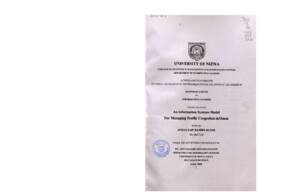Document
An information system model for managing traffic congestion in Oman.
Source
Master's thesis
Country
Oman
City
Nizwa
Publisher
University of Nizwa
Gregorian
2020
Language
English
Thesis Type
Master's thesis
English abstract
Traffic congestion has many negative effects, as this problem increases the rate of air
pollution, which in turn affects the health of the individual and the climate. Congestion is a global
phenomenon, not regional or local, and it means that traffic flow on the roads does not flow at the
usual rates, which impedes the access of road users to the intended places at the possible times.
This research thesis intends to achieve an experimental and explanatory research questions which
have been formulated and solved carefully to generate a classification model, resulting in
generating significant recommendations that could minimize the traffic congestion problem in
sultanate of Oman. This research work attempts to do analysing, classifying and visualizing,
understanding the situation of the traffic congestion in Sultanate of Oman. The data analysis
process and the mixed methodology of quantitative and qualitative approaches supported by the
exploratory analysis have been proposed. As a source of information, a database of accident
records over several years was collected from ROP and investigated upon. In total, the traffic
accident data obtainable in three data sets contains about 105,000 records describing the vehicle
accident profiles. The survey data set contains 420 respondent cases and 23 questions presented as
variables. Using several techniques and filtering methods, this work answers all research questions
in a systemic way based on reliable data analysis process. The experimental and knowledge flow
available in Weka tools have been used to develop the proposed classifier model. ‘The Receiver
Operating Characteristics (ROC) and the Precision-Recall Curve (PRC) plots have been used to
measure the sensitivity of the classifier.
This proposed work provides improved results in the classifier performance, where the
performance is improved from 75% correct classifications to 95% correct classifications and with
1.0 Precision ,1.0 Recall , 1.0 F-Measure ,1.0 ROC Area and 0.99 PRC Area . The J48 classifier
performs better than the other selected classifiers and was used for building the classifier model to
create the tree structure for generating a set of rules and recommendations. The results and
conclusions made in this work could be useful for improving road safety, driving license
management system for training and testing conducted by ROP. The results can be also useful for
insurance companies for planning to introduce life and health insurance programs for drivers and
travelers.
Category
Theses and Dissertations

